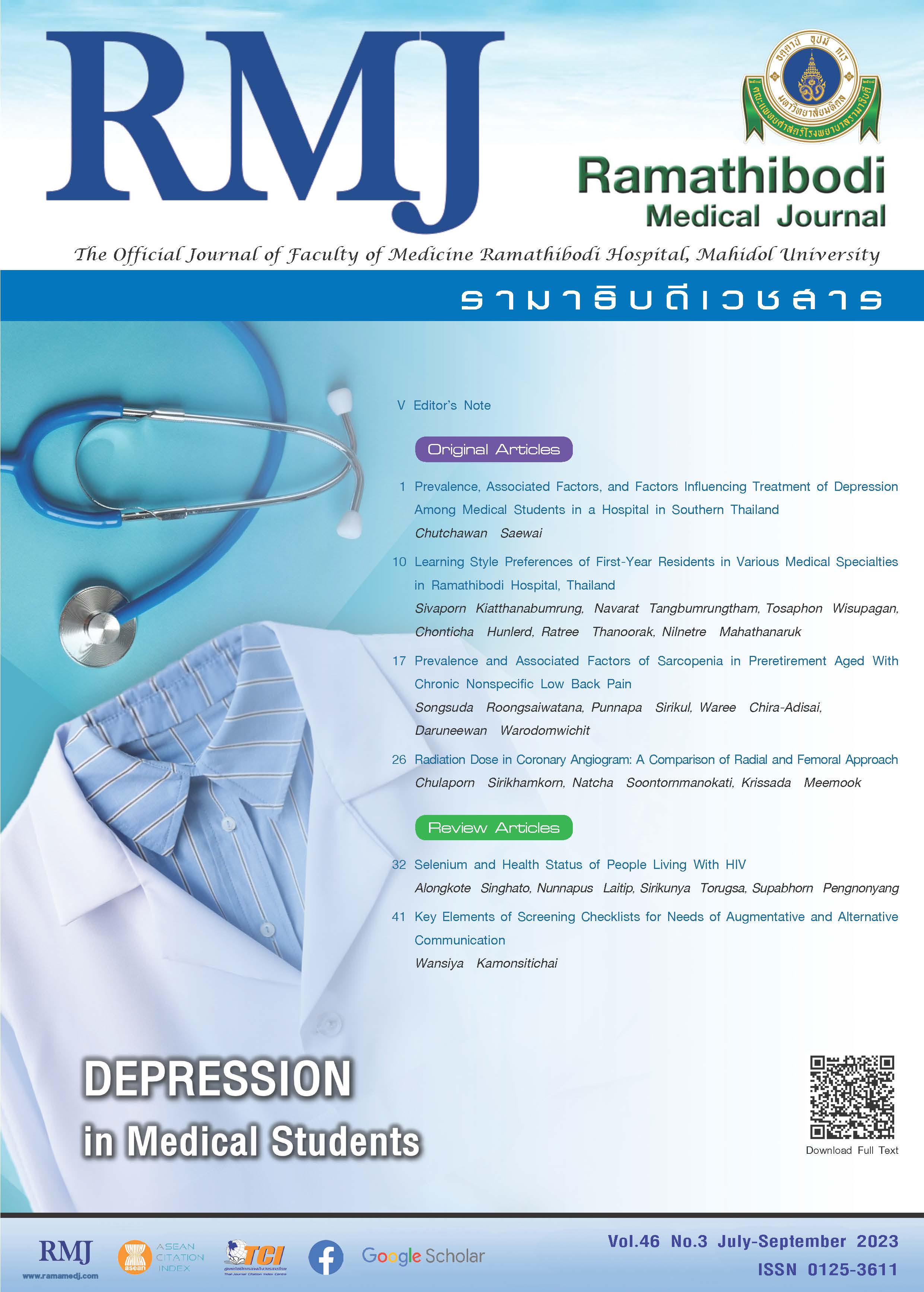Prevalence, Associated Factors, and Factors Influencing Treatment of Depression Among Medical Students in a Hospital in Southern Thailand
DOI:
https://doi.org/10.33165/rmj.2023.46.3.263528Keywords:
Depression, Medical students, Prevalence, FactorsAbstract
Background: Depression is an important mental problem for medical students globally. It affects academic performance, quality of patient care, patient safety, and may lead to suicidal ideation.
Objective: To investigate the prevalence, associated factors, and factors influencing treatment of depression in medical students.
Methods: In this cross-sectional study, fourth- and sixth-year medical students were included 96 participants in December 2022. The 9-item Patient Health Questionnaire (PHQ-9) was used to assess depression. Potential factors and the associations between potential factors and depression were analyzed using multiple logistic regression. Medical students diagnosed with depression were interviewed to explore factors that affected treatment and facilitated the seeking of proper treatment.
Results: Among 96 participants, there were 91.67% (88/96) survey respondents and revealed 42% (37/88) of the prevalence rate of depression. Associated factors were female (Adjusted OR, 11.36; 95% CI, 2.21 - 46.51), major clinical rotations (Adjusted OR, 6.89; 95% CI, 1.82 - 26.09), and insufficient knowledge of the COVID-19 pandemic (Adjusted OR, 6.21; 95% CI, 1.58 - 23.81). Nine medical students diagnosed with depression had not visited a mental health clinic. The reasons for not seeking help were the inappropriate of mental health clinic services.
Conclusions: The prevalence of depression in this current study was 42%. Associated factors were female, major clinical rotations, and insufficient knowledge of the COVID-19 pandemic.
References
American Psychiatric Association, DSM-5 Task Force. Diagnostic and Statistical Manual of Mental Disorders: DSM-5™. 5th ed. American Psychiatric Publishing, Inc; 2013. doi:10.1176/appi.books.9780890425596
World Health Organization. Depression and Other Common Mental Disorders: Global Health Estimates. World Health Organization; 2017. Accessed June 8, 2023. https://apps.who.int/iris/handle/10665/254610
World Health Organization. The World Health Report: 2001: Mental Health: New Understanding, New Hope. World Health Organization; 2001. Accessed June 8, 2023. https://apps.who.int/iris/handle/10665/42390
Phomprasith S, Karawekpanyawong N, Pinyopornpanish K, et al. Prevalence and associated factors of depression in medical students in a Northern Thailand University: a cross-sectional study. Healthcare (Basel). 2022;10(3):488. doi:10.3390/healthcare10030488
Ngasa SN, Sama CB, Dzekem BS, et al. Prevalence and factors associated with depression among medical students in Cameroon: a cross-sectional study. BMC Psychiatry. 2017;17(1):216. doi:10.1186/s12888-017-1382-3
Sherina MS, Rampal L, Kaneson N. Psychological stress among undergraduate medical students. Med J Malaysia. 2004;59(2):207-211.
Fahrenkopf AM, Sectish TC, Barger LK, et al. Rates of medication errors among depressed and burnt out residents: prospective cohort study. BMJ. 2008;336(7642):488-491. doi:10.1136/bmj.39469.763218.BE
Frank E, Biola H, Burnett CA. Mortality rates and causes among U.S. physicians. Am J Prev Med. 2000;19(3):155-159. doi:10.1016/s0749-3797(00)00201-4
O’Byrne L, Gavin B, Adamis D, Lim YX, McNicholas F. Levels of stress in medical students due to COVID-19. J Med Ethics. 2021;47(6):383-388. doi:10.1136/medethics-2020-107155
Tjia J, Givens JL, Shea JA. Factors associated with undertreatment of medical student depression. J Am Coll Health. 2005;53(5):219-224. doi:10.3200/JACH.53.5.219-224
Roh MS, Jeon HJ, Kim H, Cho HJ, Han SK, Hahm BJ. Factors influencing treatment for depression among medical students: a nationwide sample in South Korea. Med Educ. 2009;43(2):133-139. doi:10.1111/j.1365-2923.2008.03255.x
Kolkijkovin V, Phutathum S, Natetaweewat N, et al. Prevalence and associated factors of depression in medical students at Faculty of Medicine Vajira Hospital, Urban University. J Med Assoc Thai. 2019;102(9):104.
Limsricharoen K, Handee N, Chulakdabba S. Prevalence and associated factors of depression in second to sixth years medical students, Faculty of Medicine in Thailand. J Psychiatr Assoc Thai. 2014;59(1):29-40.
Auchayasawat S. Prevalence and factors associated with depression among the clinical medical students of a Faculty of Medicine in Northeast Thailand. Srinagarind Med J. 2021;36(2):200-208.
Lotrakul M, Sumrithe S, Saipanish R. Reliability and validity of the Thai version of the PHQ-9. BMC Psychiatry. 2008;8:46. doi:10.1186/1471-244X-8-46
Radcliffe C, Lester H. Perceived stress during undergraduate medical training: a qualitative study. Med Educ. 2003;37(1):32-38. doi:10.1046/j.1365-2923.2003.01405.x
Apiwatanasiri C, Somaketrarin K, Suraprayoon K, et al. Stress and coping in medical students at clinical level, Khon Kaen University. Srinagarind Med J. 2007;22(4):416-424.
Houpy JC, Lee WW, Woodruff JN, Pincavage AT. Medical student resilience and stressful clinical events during clinical training. Med Educ Online. 2017;22(1):1320187. doi:10.1080/10872981.2017.1320187
Dyrbye LN, Thomas MR, Harper W, et al. The learning environment and medical student burnout: a multicentre study. Med Educ. 2009;43(3):274-282. doi:10.1111/j.1365-2923.2008.03282.x
Voltmer E, Köslich-Strumann S, Voltmer JB, Kötter T. Stress and behavior patterns throughout medical education - a six year longitudinal study. BMC Med Educ. 2021;21(1):454. doi:10.1186/s12909-021-02862-x
Downloads
Published
How to Cite
Issue
Section
License
Copyright (c) 2023 Ramathibodi Medical Journal

This work is licensed under a Creative Commons Attribution-NonCommercial-NoDerivatives 4.0 International License.

















